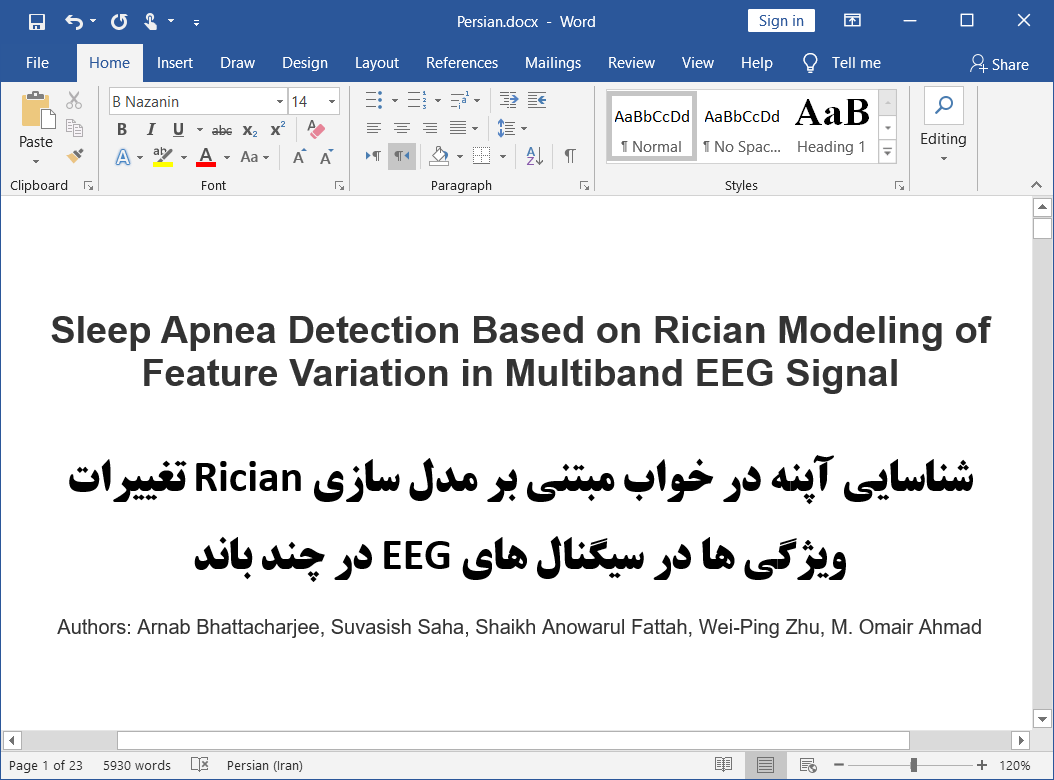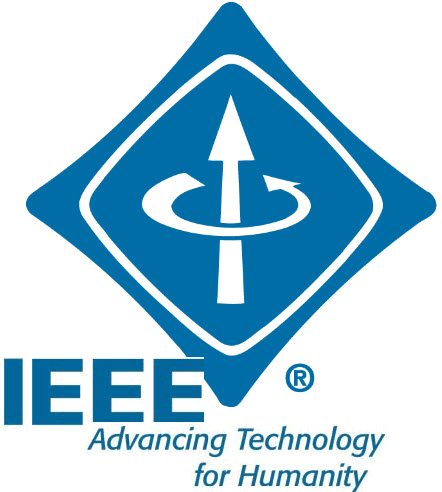تشخیص تنگی نفس موقتی (آپنه) در خواب بر پایه مدل سازی Rician تغییرات ویژگی ها در سیگنال های EEG در چند باند


شاپا پرینت: 2168-2194 وبسایت مرجع رفرنس دارد
18,500 تومانشناسه فایل: 13417
- حجم فایل ورد: 2.1MB حجم پیدیاف: 800.2KB
- فرمت: فایل Word قابل ویرایش و پرینت (DOCx)
- تعداد صفحات فارسی: 23 انگلیسی: 10
- دانشگاه:
- Department of ECE, Concordia University, Quebec, Canada
- Department of EEE, BUET, Dhaka, Bangladesh
- ژورنال: IEEE Journal of Biomedical and Health Informatics
چکیده
آپنه در خواب، که یکی از اختلال های جدی در خواب است و جمعیت زیادی از آن رنج می برند، باعث اختلال در تنفس در طول خواب می شود. در این مقاله، یک طرح شناسایی خودکار آپنه با استفاده از سیگنال های EEG تک کابل ارائه شده است که باعث می شود بین بیماران آپنه و افراد سالم تمایز ایجاد شود و بتوان رخداد های آپنه و غیر آپنه را در بیماران مبتلا به مشکل آپنه را بررسی کرد که این کار، کار دشواری می باشد. یک طرح استخراج ویژگی از فریم های فرعی از چند باند به صورت منحصر به فرد در این مقاله توسعه یافته است که با استفاده از آن می توان الگوی تغییرات ویژگی را در یک قاب از داده های EEG، شناسایی کرد که این ویژگی ها می تواند مشخصه های کاملا متفاوتی را در فریم های مرتبط با آپنه و رخداد های غیر آپنه ای ارائه کند. در این مقاله ها مشخص شده است که استفاده از پارامتر های مدل Rician همراه با معیار های آماری می تواند کیفیت های ویژگی بسیار قوی از نظر معیار عملکرد استاندارد ارائه کند، مانند فاصله Bhattacharyya و شاخص تفکیک پذیری هندسی. برای دسته بندی، ویژگی های پیشنهاد شده در روش دسته بندی نزدیکترین همسایه K (KNN) مورد استفاده قرار می گیرد. از آزمایش های گسترده و تحلیل های انجام شده بر روی دیتابیس هایی که به صورت عمومی در دسترس می باشد، مشخص شده است که روش پیشنهاد شده می تواند عملکرد بهتری از نظر حساسیت، ویژگی و صحت دسته بندی ارائه کند.
مقدمه مقاله
آپنه در خواب یکی از اختلال های رایج در خواب می باشد که باعث می شود کیفیت خواب بیمار دچار مشکل شود و بر روی 5 تا 20% از جمعیت بالغ تاثیر دارد [1و2]. بر اساس معیار آکادمی پزشکی خواب در آمریکا (AASM)، زمانی تشخیص آپنه ایجاد می شود که کاهش در جریان هوا 90%≤ می باشد و این کاهش بیشتر از 10 ثانیه طول می کشد. آپنه ضعیف نیازمند 30%≤ کاهش جریان هوا برای مدت زمان بیشتر از 10 ثانیه و یا کاهش اشباع اکسیژن 3%≤ و یا یک انگیختگی می باشد [3]. بیمارانی که به آپنه در خواب دچار هستند معمولا سردرد های شدید، خواب آلودگی در طول روز و بیماری های قلبی- تنفسی مختلف دارند.
در پلی سومنوگرافی در طول شب (PSG)، رخداد های آپنه در کل شب به صورت دستی توسط یک فرد متخصص شاخص بندی می شود که این کار یک کار پر هزینه، خسته کننده و زمان بر می باشد و ممکن است اشتباهات انسانی بر روی آن موثر باشند [6]. در نتیجه، یک الزام برای الگوریتم های خودکار شناسایی آپنه وجود دارد. طرح های مختلفی برای شناسایی آپنه به صورت خودکار با استفاده از سیگنال های زیستی مختلف وجود دارد که می توان به EEG اشاره کرد [7-13]. به عنوان مثال، در [7]، تغییرات در نرخ قلب، فشار بینی، EOG، EMG، دمای بینی و دهان و در [8]، اشباع اکسیژن، ضربان قلب و سیگنال های تنفسی و در [9]، سیگنال EMG و در [10]، سایز مردمک و در [11]، تنها سیگنال EEG و در [12] سیگنال اکسیژن سنجی، و در [13]، سیگنال ECG، EMG و EOG سیگنال هایی هستند که مورد استفاده قرار گرفته اند.
(متن کامل در فایل ورد موجود است)
ABSTRACT Sleep Apnea Detection Based on Rician Modeling of Feature Variation in Multiband EEG Signal
Sleep apnea, a serious sleep disorder affecting a large population, causes disruptions in breathing during sleep. In this paper, an automatic apnea detection scheme is proposed using single lead electroencephalography (EEC) signal to discriminate apnea patients and healthy subjects as well as to deal with the difficult task of classifying apnea and non apnea events of an apnea patient. A unique multiband subframe based feature extraction scheme is developed to capture the feature variation pattern within a frame of EEC data, which is shown to exhibit significantly different characteristics in apnea and nonapnea frames. Such within frame feature variation can be better represented by some statistical measures and characteristic probability density functions. It is found that use of Rician model parameters along with some statistical measures can offer very robust feature qualities in terms of standard performance criteria, such as Bhattacharyya distance and geometric separability index. For the purpose of classification, proposed features are used in K Nearest Neighbor classifier. From extensive experimentations and analysis on three different publicly available databases it is found that the proposed method offers superior classification performance in terms of sensitivity, specificity, and accuracy.
Introduction
Sleep apnea, a common sleep disorder deteriorating sleep quality of the patients, affects about 5-20% of adult population [1], [2]. According to American Academy of Sleep Medicine (AASM) criteria, apnea is scored where reduction in airflow is ≥90% and it stays like so for more than 10 seconds. Hypopnea criterion requires ≥30% reduction in airflow for more than 10 seconds in association with either ≥3% oxygen desaturation or an arousal [3]. Sleep apnea patients generally experience severe headaches, daytime sleepiness and several cardio-respiratory disorders [4]-[5].
In overnight polysomnography (PSG), the whole night apnea events are manually scored by an expert, which is expensive, tedious, time consuming and prone to human error [6]. As a result, there is a great necessity for an automatic sleep apnea detection algorithm. Different automatic apnea detection schemes using various biomedical signals including EEG are presented in [7]-[13]. For example, in [7], heart rate variability, nasal pressure, EOG, EMG, oronasal temperature, in [8], Oxygen saturation, heart rate variability and the respiratory signals, in [9] EMG signal, in [10] pupil size, in [11] only ECG signal, in [12] oximetric signal, in [13] ECG, EMG, EOG signals are used.
Instead of utilizing several physiological signals, EEG signal alone is getting special attention by the researches because of its successful application in analyzing sleep related problems [14]-[23]. In [14] non-linear behavior of EEG signal is studied. EEG scaling exponents computed by detrended fluctuation analysis (DFA) are used as features to classify apnea and healthy subjects in [14]. In [15], Hermite decomposition algorithm based on particle swarm optimization is proposed and [16], [17] employ wavelet transform of EEG to identify sleep apnea events. Instead of utilizing the full band EEG signal, an effective way is to divide the EEG signal into well known EEG sub-bands, namely delta, theta, alpha, sigma and beta and analyze the band limited signals. In [18], energy and variance computed from each sub-band are used as features for apnea classification. Bispectral characteristics of EEG signal are studied in [19], where in each subband the degree of quadratic phase coupling (QPC) is analyzed. Sleep apnea is detected from the variation of Hilbert spectrum frequency in [20]. Cumulative delta-power ratio of overlapping frames is used for classification in [21] while in [22], multi-band entropy values are used as features to exploit the random characteristics of EEG signal. In [23], statistical features are extracted from the variation of Beta band energy within an EEG frame and used for the purpose of classification. Most of the reported methods consider classification between apnea and healthy subjects and the difficult task of discriminating apnea and non-apnea events is rarely attempted.
In this paper, a sub-frame based model fitting approach is proposed where both these classification scenarios are taken into consideration. First, a multi-band sub-frame based scheme is introduced to extract the feature variation pattern within a frame. Next, the feature variation patterns are processed using statistical analysis and modeled with characteristic probability density function. Resulting model parameters and some statistical measures are used in K nearest neighbor (KNN) classifier to classify apnea and non-apnea frames. Detail experimentations and performance analyses are carried out in three different publicly available databases. The uniqueness of the proposed method lies in modeling the within-frame feature variation pattern and utilizing the fitted model parameters as potential features in the classification scheme, which offers very low feature dimension. Unlike using multiple bio-signals, this paper focuses on automatic detection of sleep apnea using single lead EEG signal which makes the system cost effective and can lead to an auto-diagnostic device favorable for in home care.
- مقاله درمورد تشخیص تنگی نفس موقتی (آپنه) در خواب بر پایه مدل سازی Rician تغییرات ویژگی ها در سیگنال های EEG در چند باند
- پروژه دانشجویی تشخیص تنگی نفس موقتی (آپنه) در خواب بر پایه مدل سازی Rician تغییرات ویژگی ها در سیگنال های EEG در چند باند
- تشخیص تنگی نفس موقتی در خواب
- پایان نامه در مورد تشخیص تنگی نفس موقتی (آپنه) در خواب بر پایه مدل سازی Rician تغییرات ویژگی ها در سیگنال های EEG در چند باند
- تحقیق درباره تشخیص تنگی نفس موقتی (آپنه) در خواب بر پایه مدل سازی Rician تغییرات ویژگی ها در سیگنال های EEG در چند باند
- مقاله دانشجویی تشخیص تنگی نفس موقتی (آپنه) در خواب بر پایه مدل سازی Rician تغییرات ویژگی ها در سیگنال های EEG در چند باند
- تشخیص تنگی نفس موقتی (آپنه) در خواب بر پایه مدل سازی Rician تغییرات ویژگی ها در سیگنال های EEG در چند باند در قالب پاياننامه
- پروپوزال در مورد تشخیص تنگی نفس موقتی (آپنه) در خواب بر پایه مدل سازی Rician تغییرات ویژگی ها در سیگنال های EEG در چند باند
- گزارش سمینار در مورد تشخیص تنگی نفس موقتی (آپنه) در خواب بر پایه مدل سازی Rician تغییرات ویژگی ها در سیگنال های EEG در چند باند
- گزارش کارورزی درباره تشخیص تنگی نفس موقتی (آپنه) در خواب بر پایه مدل سازی Rician تغییرات ویژگی ها در سیگنال های EEG در چند باند
